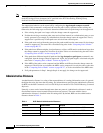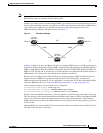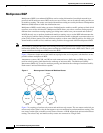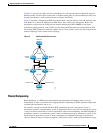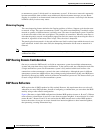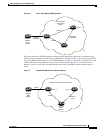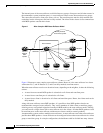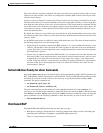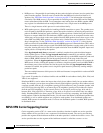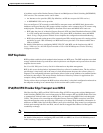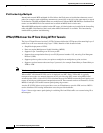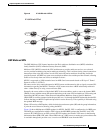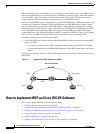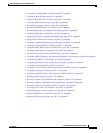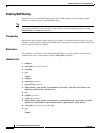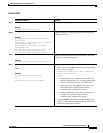
Implementing BGP on Cisco IOS XR Software
Information About Implementing BGP on Cisco IOS XR Software
RC-38
Cisco IOS XR Routing Configuration Guide
OL-14356-01
• bRIB process—Responsible for performing the best-path calculation of routes (receives partial best
paths from the speaker). The best route is installed into the bRIB and is advertised back to all
speakers. See “BGP Best Path Algorithm” section on page RC-27 for information on best-path
calculation. The bRIB process is also responsible for installing routes in the RIB, and for handling
routes redistributed from the RIB. To accommodate route leaking from one RIB to another, bRIB
may register for redistribution from multiple RIB routes into a single route in the bRIB process.
There is a single instance of this process for each address family.
• BGP speaker process—Responsible for handling all BGP connections to peers. The speaker stores
received paths in the RIB and performs a partial best-path calculation, advertising the partial best
paths to the bRIB (limited best-path calculation). Speakers perform a limited best-path calculation
because to compare Multi Exit Discriminators (MEDs), paths need to be compared from the same
AS but may not be received on the same speaker. Because BGP speakers do not have access to the
entire BGP local RIB, BGP speakers can perform only a limited best-path calculation. (These are
Step 1 through Step 7 in the “BGP Best Path Algorithm” section on page RC-27.) Only the best
paths are advertised to the bRIB to reduce speaker/bRIB interprocess communications (IPC) and to
reduce the number of paths to be processed in the bRIB. BGP speakers can only mark a path as active
only after learning the result of the full best-path calculation from the bRIB. Neighbor import and
export policies are imposed by the speaker.
If the bgp bestpath med always command is enabled, complete best-path calculation happens
inside speaker process. When the bgp bestpath med always command is not enabled, speakers
calculate partial best paths only (performs the best-path steps up to the MED comparison) and send
them to bRIB. bRIB calculates the final best path (performs all the steps in the best-path
calculation). When the bgp bestpath med always command is enabled, speakers can compare the
MED across all ASs, allowing the speaker to calculate a single best path to send it to bRIB. bRIB is
the ultimate process that calculates the final best path, but when the bgp bestpath med always
command is enabled, the speakers send a single best path instead of potentially sending multiple
partial best paths.
There are multiple instances of this process in which each instance is responsible for a subset of BGP
peer connections.
Up to a total 15 speakers for all address families and one bRIB for each address family (IPv4, IPv6, and
VPNv4) are supported.
Distributed BGP is used to reduce the impact that a fault in one address family has on another address
family. For example, you can have one speaker with only IPv6 neighbors (peering to IPv6 addresses) and
a separate speaker with only IP v4 neighbors (peering to IPv4 addresses), and yet another speaker with
only VPNv4 provider edge (PE) or customer edge (CE) neighbors (peering to IPv4 addresses distinct
from the non-VPN neighbors). In this scenario, there is no overlap in processes (bgp, brib, and rib)
between IPv4, IPv6, and VPNv4. Therefore, a bgp, brib, or rib process crash affects only one address
family. Distributed BGP also allows more CPU capacity for receiving, computing, and sending BGP
routing updates. When in distributed BGP mode, you can control the number of distributed speakers that
are enabled, as well as which neighbors are assigned to each speaker. If no distributed speakers are
enabled, BGP operates in standalone mode. If at least one distributed speaker is enabled, BGP operates
in distributed mode.
MPLS VPN Carrier Supporting Carrier
Carrier supporting carrier (CSC) is a term used to describe a situation in which one service provider
allows another service provider to use a segment of its backbone network. The service provider that
provides the segment of the backbone network to the other provider is called the backbone carrier. The
service provider that uses the segment of the backbone network is called the customer carrier.



